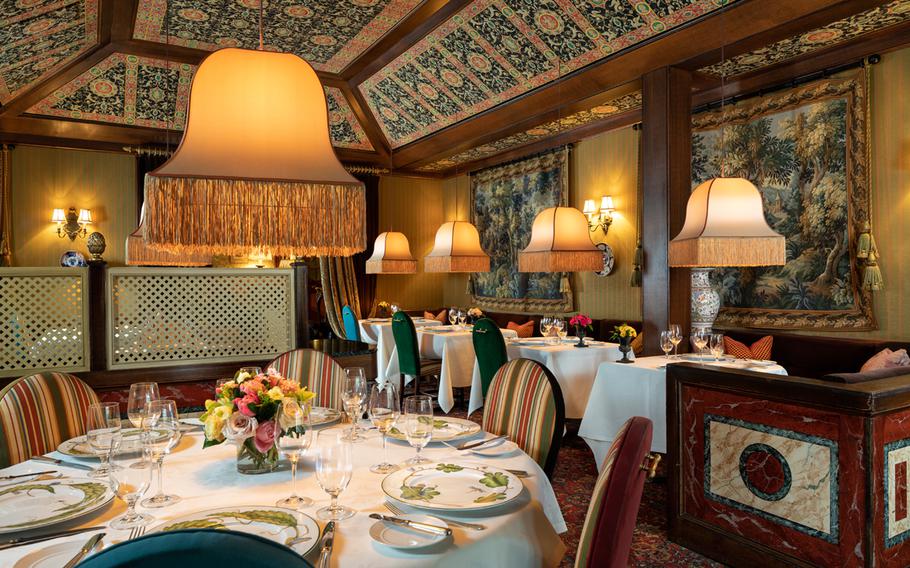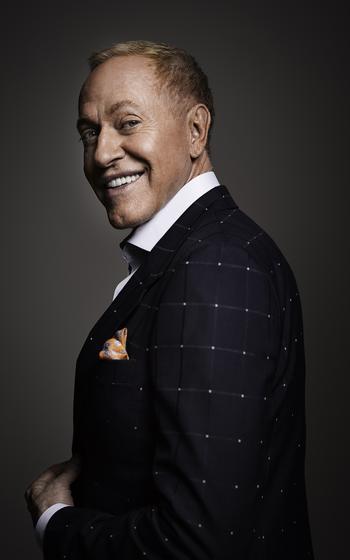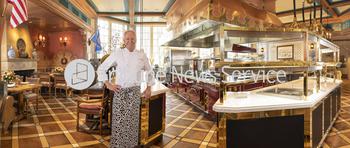
The main dining room at The Inn at Little Washington in Washington, Va., is cozy and elegant. (The Inn at Little Washington/TNS)
WASHINGTON, Va. — Patrick O’Connell got his first job in a restaurant when he was just 15, and still thought he wanted to be an actor when he grew up. His middle-class parents weren’t thrilled by his work at Mr. H’s Hamburgers, “but I loved it,” he says, because the takeout joint’s owners were “real and gritty.” He was also drawn to the kitchen’s pulsing energy.
Yet the seeds that helped O’Connell grow into one of America’s most celebrated chefs and luxury innkeepers were actually sown much earlier, when he was a little boy at the side of his maternal grandmother, Nora.
A resourceful, Depression-era cook, she would step into her Wisconsin kitchen during his summer vacations carrying an apron full of apples, “and then there would be a wonderful pie in the oven,” the chef recalls in a quiet, pillowed nook overlooking a koi pond in The Inn at Little Washington’s luxurious dining room. “She was always finding things that had been discarded and turning them into something healthy. ... Her self-sufficiency was so alluring. ... I regarded her as a magician.”

Patrick O’Connell is chef and owner of The Inn at Little Washington. (The Inn at Little Washington/TNS)
Cameron Smith is both the maítre du fromage and first-ever water sommelier at the inn.
Born on South Capitol Street in Washington and raised in suburban Clinton, Md., O’Connell studied theater at Catholic University while waiting tables in the late 1960s.
“I liked the idea of inhabiting someone else’s reality, and being someone other than yourself,” he says.
Growing up in Prince George’s County, he knew there was a big, bold world out there. So “as soon as I could, I ran” after college to Europe. His year abroad both deepened his love of food and his appreciation for the art of the table. “The food was so glorious,” especially in France. “And the reverence the culture had for chefs and restaurants was amazing. It was an art form.”
Purchase and prediction
A friend had advised him to buy property in rural Virginia before he left on his European adventure in 1967 so he’d have somewhere to come home to. It was nothing more than a small mountain shack in the foothills of the Blue Ridge Mountains, he says, but when he returned a year later to ponder his future, it afforded him a place in which to cook, garden and devour cookbooks from the local library.
Along the way, he fell in love with cooking his way through Julia Child’s cookbooks. Friends were so amazed by the results that eventually he moved to a larger farmhouse and opened a catering business with former partner Reinhardt Lynch, using only an electric frying pan they bought at a yard sale for $1.59, a wood-burning stove and a business card typed on an $8 typewriter.
Soon after opening the catering business in 1972, O’Connell got to meet Child herself at an event put on by the Mount Vernon Ladies’ Association. Starstruck, he blurted out that he was catering events with her recipes, “but not making any money.” To which she responded, “Oh, but you will. Surely you will!”
“And it was like a voice from on high,” he says.
He never looked back.
Eventually the couple’s fabulous parties and dinners found an eager audience in the horsey set around Middleburg (he catered the wedding reception of Elizabeth Taylor and John Warner in 1976).
By 1978, O’Connell and Lynch had saved enough money to not only rent half of an 1895 garage in the tiny village of Washington (population: 150), but also to build a proper kitchen. O’Connell was just 33 then, and a self-taught cook.
The spot wasn’t completely new; he had driven by the gas station as a child with his four brothers and parents on family vacations in the Shenandoah Valley. The town itself is named for our first president, who is said to have danced in a building that’s now part of the inn. (The “Little” in its name distinguishes it from the nation’s capital.)
The Inn at Little Washington gets very big
Over the years, O’Connell has grown his restaurant into a 25-building complex on 17 acres that employs nearly 300 people, making it Rappahannock County’s largest employer.
“It’s become a campus,” he says.
After the Washington Times declared the inn the best restaurant within a 150-mile radius of Washington, D.C. — three weeks after it opened — things really took off.
With the nearest grocery store 40 miles away, “this area was starved for anything,” the chef says.
The decor is just as fantastic as the food. Silk umbrellas made in Bali from a William Morris fabric adorn tables in the English-style, glass-enclosed conservatory. Threaded with lights, it looks like the moon is coming through treetops. The ceiling in the dining room features linen panels that were hand-painted and crinkled to look like old leather and then gold-leafed by hand.
The woodwork throughout has been faux-grained — a favorite technique of George Washington — by fifth-generation artist Malcolm Robson, who has worked at Buckingham Palace, and his son, Paul.
Some of the rooms are quite dramatic; others are smaller and more subtle.
“We have intended small spaces, so (guests) don’t see everything all at once,” O’Connell says. “There’s no place like it.”
Like the stages he performed on in his youth, “you only see beauty.”
Guest rooms ($657 and up) were modeled after those in the world’s great hotels, inns and country houses. They were created by London stage and set designer Joyce Evans and named after culinary pioneers like Jacques Pepin, Alice Waters and O’Connell’s mentor, Child.
The inn opened in 1984 to rave reviews. Five years later, it was the first establishment ever to receive five-star ratings for both cuisine and accommodations from Mobil Travel Guide (now Forbes Travel Guide). A gift shop followed in 1996.
Locally sourced menu
Then, as now, O’Connell relies on a network of area farms for both meat and regional produce along with what is grown in the inn’s own farms and gardens. The campus also includes an apiary, greenhouses and space to raise chickens and sheep.
“No one knew Virginia had such a long growing season,” he says.
When the inn first opened, the mimeographed menu featured two dinners (shrimp scampi and veal scallopini), for $4.95 each (about $25 in 2025 dollars). It wasn’t as focused on presentation and creating a “wow factor” as it is today. As O’Connell puts it, “we had to bring the clientele along.”
For the first 15 years, dining was a la carte, but meals eventually became prix fixe both to streamline service and make dining there more of an adventure and experience for guests.
“We wanted to create and compose (meals) with a beginning and an end rather than (have guests order dishes) that was nilly willy and didn’t complement each other,” O’Connell says.
Currently, the seven-course, prix fixe French-influenced dinner menu costs $385 per person, or $635 with wine.
“It’s a much better value now,” O’Connell says.
It’s far less expensive to dine across the street at its cozy sister restaurant, the all-day Patty O’s Cafe & Bakery, which opened in 2021 in a converted 1950s gas station.
Upholding a reputation
Located approximately 67 miles west of Washington, the inn is one of only 16 Michelin three-star restaurants in the U.S. and the only one in Virginia. (It earned its first two-star rating in 2016.)
In 2019, The Inn at Little Washington became one of just 36 restaurants in the U.S. to receive a Green Star from Michelin, a designation awarded for upholding outstanding sustainable and eco-friendly culinary practices. In addition, it’s received two five-diamond awards from AAA.
Many of the guests who make the journey to the rural town live in the DMV, but the six-time James Beard Award-winning chef draws a national and international crowd, too.
O’Connell, who took sole control of the business in 2007, shows no signs of softening his perfectionist approach or slowing down at age 79. As he leads a tour of the inn’s luxurious guest rooms and suites, he is continually stopping to straighten a painting, soften a bedspread or nudge a chair to its proper spot on the carpet.
What keeps him going is the energy he felt way back when working at the burger joint and still experiences today in the inn’s much more opulent kitchen. Inspired by one at Windsor Castle, it features an elaborate bright red French-made range by Molteni.

The kitchen at The Inn at Little Washington features a striking, fire-engine red custom Molteni range suite. (The Inn at Little Washington/TNS)
“Putting a show on and moving faster than anyone .... it has its rewards,” he says. “Every day and plate is new, so you’re (being) creative every minute.”
It’s physically tiring, to be sure, especially for someone who has worked in restaurants for more than 60 years, “but it’s therapeutic at the same time,” he says. “It’s a satisfying tiredness.”
As the inn nears its 50th year, O’Connell says it’s just catching its wind.
“We’re just warmed up and ready to party,” he says.